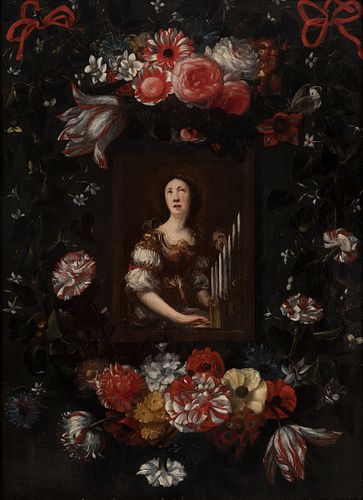MICHEL DE BOUILLON (Belgium, act. 1638 - 1673). "Saint Cecilia in a border of flowers". Oil on oak panel. It has a frame following 17th century mod
Lot 105
About Seller
Setdart Auction House
Carrer Aragó 346
Barcelona
Spain
Setdart Subastas was born in 2004 and is currently the first online art auction in Spain with solidity, prestige and reliability guaranteed by our more than 60,000 users. Setdart has a young, dynamic and enterprising team ready to successfully manage the purchase and sale of art works through custom...Read more
Estimate:
EUR€30,000 - EUR€35,000
$32,258.06 - $37,634.41
Absentee vs Live bid
Two ways to bid:
- Leave a max absentee bid and the platform will bid on your behalf up to your maximum bid during the live auction.
- Bid live during the auction and your bids will be submitted real-time to the auctioneer.
Bid Increments
| Price | Bid Increment |
|---|---|
| EUR€0 | EUR€10 |
| EUR€200 | EUR€25 |
| EUR€500 | EUR€50 |
| EUR€1,000 | EUR€100 |
| EUR€3,000 | EUR€200 |
| EUR€5,000 | EUR€500 |
| EUR€10,000 | EUR€1,000 |
| EUR€20,000 | EUR€2,000 |
| EUR€50,000 | EUR€5,000 |
About Auction
By Setdart Auction House
Oct 20, 2021
Set Reminder
2021-10-20 07:30:00
2021-10-20 07:30:00
America/New_York
Bidsquare
Bidsquare : OLD MASTERS
https://www.bidsquare.com/auctions/setdart-auction-house/old-masters-7700
Setdart Auction House sofia@setdart.com
Setdart Auction House sofia@setdart.com
- Lot Description
MICHEL DE BOUILLON (Belgium, act. 1638 - 1673). "Saint Cecilia in a border of flowers". Oil on oak panel. It has a frame following 17th century models. It has slight restorations and a crack in the upper area. Measurements: 75,5 x 55,5 cm; 107 x 86 cm (frame). In the centre of a profuse and sumptuous floral decoration is inscribed the long bust of a woman. The woman's pearly skin stands out against the dark tonality of the background. Her pious gaze and the accompaniment of the organ define the young woman as Saint Cecilia. It is worth mentioning that the scene is completed by the presence of a face above the organ, which is barely visible. This aesthetic play invites the viewer to think of a representation that goes beyond the portrait of the saint. The artist has given the painting an intuitive, unforced perspective, allowing the figures to breathe, their attitudes and gestures differing greatly. In the first quarter of the 17th century a new form of flower painting was developed in Flemish painting, which, recreated by a large group of artists and workshops, would achieve considerable success throughout the century in much of Europe: the garland of flowers as a framing and enhancing element for a central religious theme. Brueghel de Velurs was the initiator of this type of composition, particularly linked in his work to the depiction of the Virgin and Child. However, it was his pupil, the Jesuit Daniel Seghers, who was the dominant figure in this specialised production and the creator of a prototype that would serve as a model for the numerous artists who followed in his wake. Aesthetically the work is related to the painting of Michel de Bouillon, firstly in its style and composition. Although Michel de Bouillon, as we can see from his catalogued works, was a painter of great quality and remarkable skill, we know little certainty about his biography. He is thought to have been born in Ere, near Tournai in present-day Belgium. In 1638 he joined the painters' guild of Saint Luke in Tournai, where he spent most of his career, as the archives of this institution indicate. There he executed a large ephemeral work as a solemn entrance arch for the arrival in the city of King Louis XIV of France in 1670, two years after his conquest of the city. Bouillon mainly painted still lifes and garlands of flowers, sometimes with religious scenes or grisaille imitating classical reliefs. He was also highly regarded for his still lifes of "vanitas". His works are to be found in museums and important private collections, such as "Garland of Flowers with Landscape and the Flight into Egypt" in the Musée des Beaux-Arts in Tournai, two still lifes with fish and birds in the Musée des Beaux-Arts in Bernay and a "Vase with Flowers, Fruit and Butterflies on an Architectural Background" in the Doucet collection in Paris. In Spain there is a "Still Life of Vanitas with a Vase" in the Royal Academy of Fine Arts of San Fernando, Madrid. Much of his work, however, remains unknown. This is primarily due to the fact that these works are not signed, and their high quality and stylistic closeness to other painters has led to his authorship being confused on numerous occasions with that of other contemporary masters such as Daniel Seghers. In fact, his compositions and the quality of the textures of the flowers, leaves and animals are very similar to those of Daniel Seghers. Although it is not certain that Bouillon was one of Seghers' collaborators, what is certain is that the painter was perfectly familiar with Seghers' work, as is evident from the influence that can be seen in his output. It is also thought possible that he had a certain relationship with the painters Jean Bouillon and Philippe de Champaigne.
- Shipping Info
-
In-house shipping available. Please inquire at admin@setdart.com.
-
- Buyer's Premium



 EUR
EUR CAD
CAD AUD
AUD GBP
GBP MXN
MXN HKD
HKD CNY
CNY MYR
MYR SEK
SEK SGD
SGD CHF
CHF THB
THB









